
Home - Search - Browse - Alphabetic Index: 0- 1- 2- 3- 4- 5- 6- 7- 8- 9
A- B- C- D- E- F- G- H- I- J- K- L- M- N- O- P- Q- R- S- T- U- V- W- X- Y- Z
Luna E-6
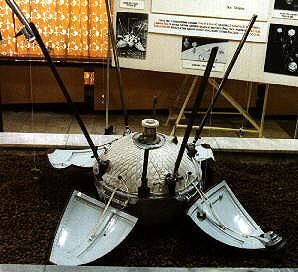 Luna 9 Korolev / Lavochkin E-6M spacecraft as flown on Luna 9 first soft landing on the moon. Credit: Andy Salmon |
AKA: E-6. Status: Operational 1963. First Launch: 1963-01-04. Last Launch: 1966-01-31. Number: 12 . Gross mass: 1,422 kg (3,134 lb).
Work began on the E-6 on 26 March 1960. The spacecraft consisted of:
- KTDU, the midcourse correction / lunar braking engine module.
- Two-part air bag system for landing the payload on the surface of the moon. The landed spacecraft itself was ejected from the main bus just above the surface; it was surrounded by this air bag to absorb the impact.
- ALS Automatic lunar station, the lander itself. The petals of the outer carapace of this capsule opened like a flower, pushing the photo platform above the surface. It was a hermetically sealed container with radio equipment, a program timing device, heat control systems, scientific apparatus, power sources, and a television system. After landing the four petals opened outward and stabilized the spacecraft on the lunar surface. Spring-controlled antennas assumed operating positions, and the television camera rotating mirror system, which operated by revolving and tilting, began a photographic survey of the lunar environment.
During the flight to the moon the spacecraft was oriented by the KTDU's SAV astronavigation system. This used five sensors (two earth, two moon, one sun) to determine the orientation of the spacecraft in relation to these three celestial objects. At 8,300 km from the lunar surface the SAV was used to determine the local vertical in relation to the moon, gyroscopes were spun up and memorized the position. 75 km above the surface the KTDU ignited. At 25 km from the surface the landing bag inflated to one atmosphere pressure, and the main engine shut off. The landing bag was ejected by a sensor just before impact with the moon, and hit the surface at 15 m/s.
The spacecraft had a launch mass of 1,470 kg and the ALS original design mass was 82 kg.
Luna 9 had a mass on release from the upper stage of 1602 kg. The KTDU main engine had a thrust of 4500 kgf and 847 kg of propellant was loaded. A total of 6 seconds of burn time was allocated for mid-course maneuvers and 45 seconds for the lunar landing braking maneuver. After the braking maneuver, with the probe some distance over the lunar surface, the burn-out mass of the entire spacecraft was 430 kg. After the impact air bag had cushioned the final bouncing impact on the surface, the final mass of the probe on the surface was 79.5 kg The television camera aboard had a resolution of 15-20 mm on objects 2 m from the camera. Batteries provided power for five days of operation on the surface, with one hour of data transmissions back to earth per day.
In the modernized E-6M version the ALS mass was increased to 150 kg. There were 12 launches of the E-6 and E-6M, of which five experienced launch vehicle failures, four guidance system failures, and three resulted in successful landings.
At the end of 1965 all materials on the E-6 were passed to the Lavochkin Bureau, who took over from Korolev responsibility for all future lunar and planetary unmanned probes.
More at: Luna E-6.
| Luna E-6S Russian lunar orbiter. Lunar lander, Russia. Launched 1966. |
| Luna E-6LF Russian lunar orbiter. Photographed lunar surface and orbital space environment in preparation for manned missions. Lunar lander, Russia. Launched 1966. |
| Luna E-6M Russian lunar lander. Luna 13. Modernized version of the E-6 with the ALS lander mass increased from 84 kg to 150 kg. Lunar soft lander, Russia. Launched 1966. |
| Luna E-6LS Russian lunar orbiter. The E-6LS was a radio-equipped version of the E-6 used to test tracking and communications networks for the Soviet manned lunar program. Lunar lander, Russia. Launched 1967 - 1968. |
Family: Moon. Country: Russia. Engines: KTDU-5A. Launch Vehicles: R-7, Molniya 8K78, Molniya 8K78/E6, Molniya 8K78M. Projects: Luna. Launch Sites: Baikonur, Baikonur LC1, Baikonur LC31. Agency: Korolev bureau, RVSN. Bibliography: 16, 2, 21, 296, 367, 376, 3827, 3828, 3837, 3843, 3844, 474, 6, 64, 65, 70, 12773.
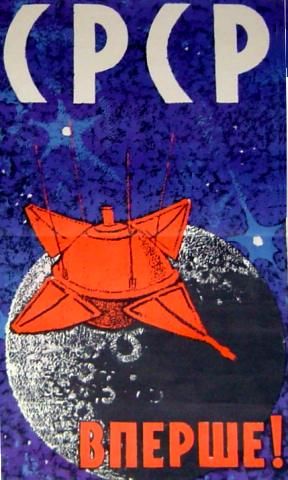 | Luna 9 Poster |
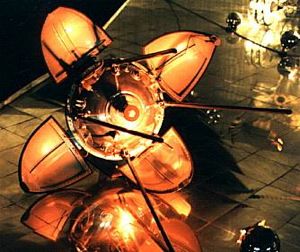 | Luna 9 Lander Credit: © Mark Wade |
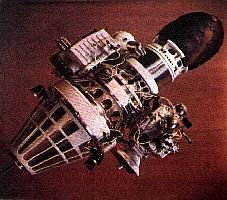 | Luna 9 Bus / E-6 Credit: NASA |
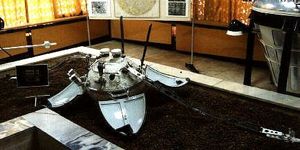 | Luna 13 Korolev / Lavochkin E-6M spacecraft as flown on Luna 13 with soil probe. Credit: Andy Salmon |
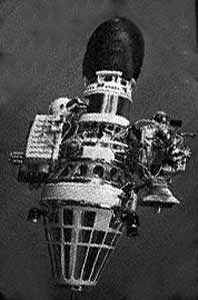 | Luna 13 Credit: Manufacturer Image |
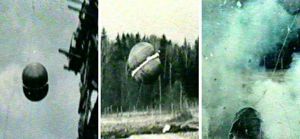 | Testing of E-6 Testing of E-6 Landing Bag Credit: RKK Energia |
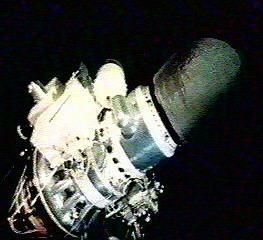 | E-6 / Luna 9 Credit: RKK Energia |
1959 December 10 - .
- Further development of Soviet Lunar and Planetary probes approved. - . Nation: Russia. Spacecraft: Luna E-6, Mars 1M. Central Committee of the Communist Party and Council of Soviet Ministers Decree 1386-618 'On the Creation of AMS for Landing on the Moon. and Flights to Venus and Mars-- approving automated lunar and interplanetary spacecraft' was issued..
1962 March 23 - .
- Luna E-6 soft lander approved. - . Nation: Russia. Spacecraft: Luna E-6. Central Committee of the Communist Party and Council of Soviet Ministers Decree 'On Luna spacecraft for soft-landing on the Moon' was issued..
1963 January 4 - . 08:49 GMT - . Launch Site: Baikonur. Launch Complex: Baikonur LC1. LV Family: R-7. Launch Vehicle: Molniya 8K78. FAILURE: The escape stage's BOZ unit failed to operate due to failure of a DC transformer of the power system. The stage with payload remained in Earth orbit.. Failed Stage: U.
- Sputnik 25 - . Payload: E-6 s/n 1. Mass: 1,422 kg (3,134 lb). Nation: Russia. Agency: Korolev bureau. Program: Luna. Class: Moon. Type: Lunar probe. Spacecraft: Luna E-6. Decay Date: 1963-01-05 . USAF Sat Cat: 522 . COSPAR: 1963-001B. Apogee: 189 km (117 mi). Perigee: 165 km (102 mi). Inclination: 64.60 deg. Period: 88.00 min.
1963 February 3 - . 09:29 GMT - . Launch Site: Baikonur. Launch Complex: Baikonur LC1. LV Family: R-7. Launch Vehicle: Molniya 8K78. FAILURE: Upper stage gyro platform failure.. Failed Stage: G.
- E-6 s/n 2 failure. - . Payload: E-6 s/n 2. Mass: 1,422 kg (3,134 lb). Nation: Russia. Agency: RVSN. Program: Luna. Class: Moon. Type: Lunar probe. Spacecraft: Luna E-6. Decay Date: 1963-02-03 . Apparent causes were instabilities in the torque sensor circuit and the pitch-free floating gyro device. The upper stages and payload broke up on re-entry into the atmosphere over the Pacific..
1963 April 2 - . 08:16 GMT - . Launch Site: Baikonur. Launch Complex: Baikonur LC1. LV Family: R-7. Launch Vehicle: Molniya 8K78.
- Luna 4 - .
Payload: E-6 s/n 3. Mass: 1,422 kg (3,134 lb). Nation: Russia.
Agency: RVSN.
Program: Luna.
Class: Moon.
Type: Lunar probe. Spacecraft: Luna E-6.
Decay Date: 1963-04-03 . USAF Sat Cat: 563 . COSPAR: 1963-008A. Apogee: 182 km (113 mi). Perigee: 167 km (103 mi). Inclination: 64.70 deg. Period: 87.98 min.
Luna 4 was the second attempted Soviet unmanned lunar soft lander probe. The spacecraft, rather than being sent on a straight trajectory toward the Moon, was placed first in an earth parking orbit. The rocket stage then reignited and put the spaccecraft on a translunar trajectory. Failure of Luna 4 to make a required midcourse correction resulted in it missing the Moon by 8336.2 km on April 6, at 4:26 a.m. Moscow time. It thereafter entered a barycentric Earth orbit. The Soviet news agency, Tass, reported that data had been received from the spacecraft throughout its flight and that radio communication would continue for a few more days.
1964 March 21 - . 08:15 GMT - . Launch Site: Baikonur. Launch Complex: Baikonur LC1. LV Family: R-7. Launch Vehicle: Molniya 8K78. FAILURE: Failure. Failed Stage: U.
- Luna failure - . Payload: E-6 s/n 4. Mass: 1,422 kg (3,134 lb). Nation: Russia. Agency: RVSN. Program: Luna. Class: Moon. Type: Lunar probe. Spacecraft: Luna E-6. Decay Date: 1964-03-21 . The upper stages burnt on re-entry into the atmosphere..
1964 April 20 - . 08:08 GMT - . Launch Site: Baikonur. Launch Complex: Baikonur LC1. LV Family: R-7. Launch Vehicle: Molniya 8K78. FAILURE: Power failure caused upper stage shutdown at T+340 seconds.. Failed Stage: U.
- Luna failure - . Payload: E-6 s/n 5. Mass: 1,422 kg (3,134 lb). Nation: Russia. Agency: RVSN. Program: Luna. Class: Moon. Type: Lunar probe. Spacecraft: Luna E-6. Decay Date: 1964-04-20 . The upper stages broke up on re-entry into the atmosphere...
During 1965 - . Launch Vehicle: N1.
- N1 development issues - .
Nation: Russia.
Related Persons: Korolev,
Pilyugin,
Raushenbakh.
Program: Lunar L3.
Spacecraft: LK,
Luna E-6,
Soyuz 7K-LOK.
There were two camps on the N1-L3 control systems. One group was within OKB-1, and had developed the systems for the Vostok and Zenit spacecraft, under the personal oversight of Korolev. They stressed the maximum quality and reliability in their systems. The second group had worked with Pilyugin, and had designed the systems for the Mars, Venus, Luna E-6 probes, the R-9, RT-1, RT-2, and GR-1 missiles; and piloted spacecraft. Their design emphasis was on maximum usability and output. Pilyugin had been named chief designer of the control system for the N1-L3. Additional Details: here....
1965 March 2 - .
- Babakin takes over Lavochkin OKB - .
Nation: Russia.
Related Persons: Babakin,
Chelomei,
Korolev.
Program: Lunar L3.
Class: Manned.
Type: Manned space station. Spacecraft: Luna E-6,
Luna Ye-8.
Former Lavochkin bureau, part of Chelomei, regained status of a separate design bureau with former Korolev deputy GN Babakin as its head. By the end of 1965 all materials on the E-6, Ye-8, and planetary probes were passed by Korolev to the Lavochkin Bureau, who took over responsibility for all future lunar and planetary unmanned probes.
1965 March 12 - . 09:30 GMT - . Launch Site: Baikonur. Launch Complex: Baikonur LC1. LV Family: R-7. Launch Vehicle: Molniya 8K78. FAILURE: The escape stage Block L's engine failed to ignite due to failure of a transformer in the power supply of the control system.. Failed Stage: U.
- Cosmos 60 - . Payload: E-6 s/n 9. Mass: 6,530 kg (14,390 lb). Nation: Russia. Agency: MOM. Program: Luna. Class: Moon. Type: Lunar probe. Spacecraft: Luna E-6. Decay Date: 1965-03-17 . USAF Sat Cat: 1246 . COSPAR: 1965-018A. Apogee: 248 km (154 mi). Perigee: 195 km (121 mi). Inclination: 64.70 deg. Period: 88.90 min. The stage with the payload remained in Earth orbit as Kosmos-60..
1965 April 10 - . Launch Site: Baikonur. Launch Complex: Baikonur LC1. LV Family: R-7. Launch Vehicle: Molniya 8K78. FAILURE: Stage 3's engine 8D715K failed due to depressurization of the nitrogen pipeline of the LOX tank pressurization system of Block I.. Failed Stage: U.
- Luna failure - stage 3 engine failure. - . Payload: E-6 s/n 8. Mass: 1,422 kg (3,134 lb). Nation: Russia. Agency: RVSN. Program: Luna. Class: Moon. Type: Lunar probe. Spacecraft: Luna E-6. Decay Date: 1965-04-10 . The upper stages fell apart on re-entry into the atmosphere...
1965 May 9 - . 07:49 GMT - . Launch Site: Baikonur. Launch Complex: Baikonur LC1. LV Family: R-7. Launch Vehicle: Molniya 8K78.
- Luna 5 - .
Payload: E-6 s/n 10. Mass: 1,474 kg (3,249 lb). Nation: Russia.
Agency: MOM.
Program: Luna.
Class: Moon.
Type: Lunar probe. Spacecraft: Luna E-6.
Decay Date: 1965-05-12 . USAF Sat Cat: 1366 . COSPAR: 1965-036A. Apogee: 219 km (136 mi). Perigee: 159 km (98 mi). Inclination: 64.80 deg. Period: 88.27 min.
Soft lunar landing attempt. Western observers, among them England's Sir Bernard Lovell, correctly speculated that the craft's mission was a soft landing. After launch fom Baikonur and five successful communications sessions the spacecraft performed a midcourse correction maneuver on 10 May. Unfortunately a problem developed in a flotation gyroscope (it did not have enough time to warm up properly) in the I-100 guidance control unit and control was lost so the spacecraft began spinning around its main axis. It was brought back under control, but at the time of the next maneuver, the main retrorocket system failed due to a ground control error in calculating the setpoints, and the spacecraft, though still headed for the Moon, was far off its intended landing site. Problems again cropped up with the I-100 unit so a retrorocket burn could not take place and Luna 5 impacted the lunar surface some 700 km from the target point at about 19:10 UT on 12 May 1965, becoming the second Soviet probe to hit the Moon. A Soviet announcement gave the impact point as the Sea of Clouds at roughly 31 degrees S, 8 degrees W. (Although a later analysis gave a very different estimate of 8 degrees N, 23 degrees W.)
1965 June 8 - . 07:40 GMT - . Launch Site: Baikonur. Launch Complex: Baikonur LC1. LV Family: R-7. Launch Vehicle: Molniya 8K78.
- Luna 6 - .
Payload: E-6 s/n 7. Mass: 1,440 kg (3,170 lb). Nation: Russia.
Agency: MOM.
Program: Luna.
Class: Moon.
Type: Lunar probe. Spacecraft: Luna E-6.
USAF Sat Cat: 1393 . COSPAR: 1965-044A.
Attempted unmanned lunar soft lander. Tass reported that all onboard equipment was functioning normally. During the mid-course correction on 9 June the main retro-rocket failed to cut off as scheduled and fired until all of its propellant was exhausted, due to an erroneous ground command sent to the timer. This put the spacecraft on a trajectory to miss the Moon. The spacecraft was put through all the motions of an actual landing, jettisoning the lander and deploying the airbags, as an apparently successful practice run for the ground crew despite the fact that it flew by the Moon at a distance of 161,000 km on 11 June. Contact was lost at a distance of 600,000 km from Earth, the spacecraft presumably entering a heliocentric orbit.
1965 September 4 - . Launch Site: Baikonur. Launch Complex: Baikonur. LV Family: R-7. Launch Vehicle: Molniya 8K78.
- E-6 Launch Postponement - . Payload: E-6. Nation: Russia. Program: Luna. Class: Moon. Type: Lunar probe. Spacecraft: Luna E-6. The launch was delayed due to malfunction of the RKS system of the Stages 1/2's control system during pre-launch service..
1965 October 4 - . 07:56 GMT - . Launch Site: Baikonur. Launch Complex: Baikonur LC1. LV Family: R-7. Launch Vehicle: Molniya 8K78M.
- Luna 7 - .
Payload: E-6 s/n 11. Mass: 1,504 kg (3,315 lb). Nation: Russia.
Agency: MOM.
Program: Luna.
Class: Moon.
Type: Lunar probe. Spacecraft: Luna E-6.
Decay Date: 1965-10-07 . USAF Sat Cat: 1610 . COSPAR: 1965-077A.
Lunar soft landing attempt. The Luna 7 spacecraft was intended to achieve a soft landing on the Moon. However, due to loss of attitude control during the final approach to the lunar surface, the retrorockets were prevented from firing to slow the spacecraft and it impacted the lunar surface at 9.8 N, 47.8 W in the Sea of Storms on 7 October 1965 at 22:08:24 UT.
1965 December 3 - . 10:46 GMT - . Launch Site: Baikonur. Launch Complex: Baikonur LC31. LV Family: R-7. Launch Vehicle: Molniya 8K78.
- Luna 8 - .
Payload: E-6 s/n 12. Mass: 1,550 kg (3,410 lb). Nation: Russia.
Agency: MOM.
Program: Luna.
Class: Moon.
Type: Lunar probe. Spacecraft: Luna E-6.
Decay Date: 1965-12-06 . USAF Sat Cat: 1810 . COSPAR: 1965-099A.
Lunar soft landing attempt failed. Luna 8's objectives were to test a soft lunar landing system and scientific research. Weighing 1,552 kg (3,422 lbs), the spacecraft was following a trajectory close to the calculated one and the equipment was functioning normally. However, a puncture to a cushioning airbag caused the spacecraft to spin, losing attitude control and preventing full firing of the retrorockets. The spacecraft impacted the lunar surface at 9.1 N, 63.3 W in the Sea of Storms at 21:51:30 UT on 6 December 1965. The mission did complete the experimental development of the star-orientation system and ground control of radio equipment, flight trajectory, and other instrumentation.
1966 January 31 - . 11:41 GMT - . Launch Site: Baikonur. Launch Complex: Baikonur LC31. LV Family: R-7. Launch Vehicle: Molniya 8K78M.
- Luna 9 - .
Payload: E-6M s/n 13. Mass: 1,580 kg (3,480 lb). Nation: Russia.
Agency: MOM.
Program: Luna.
Class: Moon.
Type: Lunar probe. Spacecraft: Luna E-6.
Decay Date: 1966-02-03 . USAF Sat Cat: 1954 . COSPAR: 1966-006A.
Soft landed on Moon; photographed surface for 3 days. Landed on Moon 3 February 1966 at 18:44:52 GMT, Latitude 7.08 N, Longitude 295.63 E - Oceanus Procellarum. The Luna 9 spacecraft was the first spacecraft to achieve a lunar soft landing and to transmit photographic data to Earth. Seven radio sessions, totaling 8 hours and 5 minutes, were transmitted as were three series of TV pictures. When assembled, the photographs provided a panoramic view of the nearby lunar surface. The pictures included views of nearby rocks and of the horizon 1.4 Km away from the spacecraft.
1966 March 1 - . 11:03 GMT - . Launch Site: Baikonur. Launch Complex: Baikonur LC31. LV Family: R-7. Launch Vehicle: Molniya 8K78M. FAILURE: The escape stage Block L lost roll control during unpowered coast in parking orbit because the axis of the course regulator of the control system jammed in the zero position. The stage's engine was not fired.. Failed Stage: U.
- Cosmos 111 - . Payload: Ye-6S s/n 204. Mass: 6,540 kg (14,410 lb). Nation: Russia. Agency: Korolev bureau. Program: Luna. Class: Moon. Type: Lunar probe. Spacecraft Bus: Luna E-6. Spacecraft: Luna E-6S. Decay Date: 1966-03-03 . USAF Sat Cat: 2093 . COSPAR: 1966-017A. Apogee: 180 km (110 mi). Perigee: 168 km (104 mi). Inclination: 51.80 deg. Period: 88.00 min.
1966 March 31 - . 10:47 GMT - . Launch Site: Baikonur. Launch Complex: Baikonur LC31. LV Family: R-7. Launch Vehicle: Molniya 8K78M.
- Luna 10 - .
Payload: E-6S s/n 206 ISL. Mass: 1,597 kg (3,520 lb). Nation: Russia.
Agency: Korolev bureau.
Program: Luna.
Class: Moon.
Type: Lunar probe. Spacecraft Bus: Luna E-6.
Spacecraft: Luna E-6S.
USAF Sat Cat: 2126 . COSPAR: 1966-027A.
Lunar Orbit (Selenocentric). Development of system to permit the creation of an artificial lunar satellite for the investigation of circumlunar space; development of onboard systems for putting a station into a selenocentric (circumlunar) orbit. Orbit: Lunar Orbiter. The Luna 10 spacecraft was launched towards the Moon from an Earth orbiting platform. The spacecraft entered lunar orbit 3 50 x 1017 km, inclination 71.9 deg to plane of the lunar equator. on April 4, 1966. Scientific instruments included a gamma-ray spectrometer for energies between 0.3--3 MeV, a triaxial magnetometer, a meteorite detector, instruments for solar-plasma studies, and devices for measuring infrared emissions from the Moon and radiation conditions of the lunar environment. Gravitational studies were also conducted. The spacecraft played back to Earth the `Internationale' during the Twenty-third Congress of the Communist Party of the Soviet Union. Luna 10 was battery powered and operated for 460 lunar orbits and 219 active data transmissions before radio signals were discontinued on May 30, 1966.
1966 August 24 - . 08:03 GMT - . Launch Site: Baikonur. Launch Complex: Baikonur LC31. Launch Pad: LC31?. LV Family: R-7. Launch Vehicle: Molniya 8K78M.
- Luna 11 - .
Payload: E-6LF s/n 101. Mass: 1,638 kg (3,611 lb). Nation: Russia.
Agency: MOM.
Program: Luna.
Class: Moon.
Type: Lunar probe. Spacecraft Bus: Luna E-6.
Spacecraft: Luna E-6LF.
USAF Sat Cat: 2406 . COSPAR: 1966-078A.
Automatic station Luna 11. Further development of artificial lunar satellite systems and conduct of scientific experiments in circumlunar space. Lunar orbit 160 km x 1200 km x 27 degrees. Luna 11 was launched towards the Moon from an earth-orbiting platform and entered lunar orbit on August 28, 1966. The objectives of the mission included the study of: (1) lunar gamma- and X-ray emissions in order to determine the Moon's chemical composition; (2) lunar gravitational anomalies; (3) the concentration of meteorite streams near the Moon; and, (4) the intensity of hard corpuscular radiation near the Moon. A total of 137 radio transmissions and 277 orbits of the Moon were completed before the batteries failed on October 1, 1966.
1966 October 22 - . 08:42 GMT - . Launch Site: Baikonur. Launch Complex: Baikonur LC31. LV Family: R-7. Launch Vehicle: Molniya 8K78M.
- Luna 12 - .
Payload: E-6LF s/n 102. Mass: 1,620 kg (3,570 lb). Nation: Russia.
Agency: MOM.
Program: Luna.
Class: Moon.
Type: Lunar probe. Spacecraft Bus: Luna E-6.
Spacecraft: Luna E-6LF.
USAF Sat Cat: 2508 . COSPAR: 1966-094A.
Lunar Orbiter, further development of artificial lunar satellite systems and conduct of scientific experiments in circumlunar space. Luna 12 was launched towards the Moon from an earth-orbiting platform and achieved a lunar orbit of of 100 km x 1740 km on October 25, 1966. The spacecraft was equipped with a television system that obtained and transmitted photographs of the lunar surface. The photographs contained 1100 scan lines with a maximum resolution of 14.9--19.8 m. Pictures of the lunar surface were returned on October 27, 1966. According to contemporary US intelligence sources, only four pictures were returned. Radio transmissions from Luna 12 ceased on January 19, 1967, after 602 lunar orbits and 302 radio transmissions.
1966 December 21 - . 10:17 GMT - . Launch Site: Baikonur. Launch Complex: Baikonur LC1. LV Family: R-7. Launch Vehicle: Molniya 8K78M.
- Luna 13 - .
Payload: E-6M s/n 205. Mass: 1,700 kg (3,700 lb). Nation: Russia.
Agency: Korolev bureau.
Program: Luna.
Class: Moon.
Type: Lunar probe. Spacecraft Bus: Luna E-6.
Spacecraft: Luna E-6M.
Decay Date: 1966-12-24 . USAF Sat Cat: 2626 . COSPAR: 1966-116A.
Soft landed on Moon 24 December 1966 at 18:01:00 GMT, Latitude 18.87 N, 297.95 E - Oceanus Procellarum. The petal encasement of the spacecraft was opened, antennas were erected, and radio transmissions to Earth began four minutes after the landing. On December 25 and 26, 1966, the spacecraft television system transmitted panoramas of the nearby lunar landscape at different sun angles. Each panorama required approximately 100 minutes to transmit. The spacecraft was equipped with a mechanical soil-measuring penetrometer, a dynamograph, and a radiation densitometer for obtaining data on the mechanical and physical properties and the cosmic-ray reflectivity of the lunar surface. It is believed that transmissions from the spacecraft ceased before the end of December 1966.
1967 May 16 - . 21:43 GMT - . Launch Site: Baikonur. Launch Complex: Baikonur LC1. LV Family: R-7. Launch Vehicle: Molniya 8K78M.
- Cosmos 159 - . Payload: E-6LS s/n 111. Mass: 4,490 kg (9,890 lb). Nation: Russia. Agency: MOM. Program: Lunar L1. Class: Moon. Type: Lunar probe. Flight: Soyuz 7K-L1 mission 1. Spacecraft Bus: Luna E-6. Spacecraft: Luna E-6LS. Decay Date: 1977-11-11 . USAF Sat Cat: 2805 . COSPAR: 1967-046A. Apogee: 60,637 km (37,678 mi). Perigee: 350 km (210 mi). Inclination: 51.60 deg. Period: 1,174.20 min. The E-6LS was a radio-equipped version of the E-6 used to test tracking and communications networks for the Soviet manned lunar program. The payload entered the desired orbit as Kosmos-159..
1968 February 7 - . 10:43 GMT - . Launch Site: Baikonur. Launch Complex: Baikonur LC1. LV Family: R-7. Launch Vehicle: Molniya 8K78M. FAILURE: At T+524.6 sec Stage 3's engine 11D55 cut off prematurely because it ran out of fuel due to an excessive fuel consumption rate through the gas-generator.. Failed Stage: U.
- E-6LS s/n 112 - .
Payload: E-6LS s/n 112. Mass: 1,700 kg (3,700 lb). Nation: Russia.
Agency: RVSN.
Program: Lunar L1.
Class: Moon.
Type: Lunar probe. Flight: Soyuz 7K-L1 mission 1.
Spacecraft Bus: Luna E-6.
Spacecraft: Luna E-6LS.
Decay Date: 1968-02-07 .
Failed launch of an E-6LS radio-equipped version of the E-6 used to test tracking and communications networks for the Soviet manned lunar program. Suggestions for the abnormal consumption included the seizing up of a pintle valve for controlling fuel supply into the regulator or the seizing up of the fuel inlet control. The upper stages broke up in the atmosphere.
1968 April 7 - . 10:09 GMT - . Launch Site: Baikonur. Launch Complex: Baikonur LC1. LV Family: R-7. Launch Vehicle: Molniya 8K78M.
- Luna 14 - .
Payload: E-6LS s/n 113. Mass: 1,700 kg (3,700 lb). Nation: Russia.
Agency: MOM.
Program: Lunar L3.
Class: Moon.
Type: Lunar probe. Spacecraft Bus: Luna E-6.
Spacecraft: Luna E-6LS.
USAF Sat Cat: 3178 . COSPAR: 1968-027A.
Lunar Orbiter; studied lunar gravitational field, Earth-Moon gravitational relationship, and conducted further scientific experiments in circumlunar space. Not revealed until years later was that the E-6LS was primarily intended to test tracking and communications networks for the Soviet manned lunar program. The Luna 14 spacecraft entered a 140 x 870 km x 42 degree lunar orbit on April 10, 1966. The spacecraft instrumentation was similar to that of Luna 10 and provided data for studies of the interaction of the earth and lunar masses, the lunar gravitational field, the propagation and stability of radio communications to the spacecraft at different orbital positions, solar charged particles and cosmic rays, and the motion of the Moon. This flight was the final flight of the second generation of the Luna series.
Back to top of page
Home - Search - Browse - Alphabetic Index: 0- 1- 2- 3- 4- 5- 6- 7- 8- 9
A- B- C- D- E- F- G- H- I- J- K- L- M- N- O- P- Q- R- S- T- U- V- W- X- Y- Z
© 1997-2019 Mark Wade - Contact
© / Conditions for Use